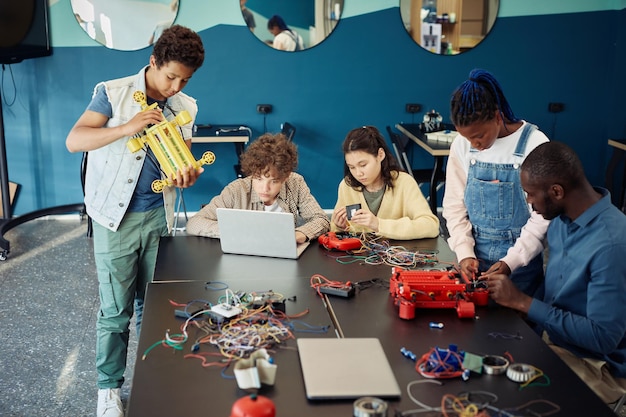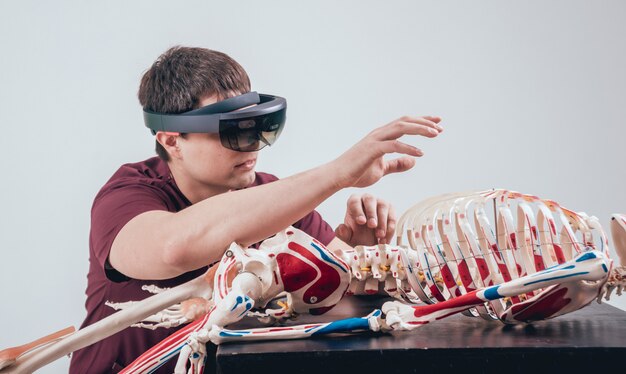New STEM Education Initiatives: What US Students Need to Know for 2025

New STEM Education Initiatives: What US Students Need to Know for 2025 encompass a range of programs and reforms designed to enhance science, technology, engineering, and mathematics education in the United States, preparing students for future careers and addressing critical skills gaps in the workforce while giving them the tools for innovation.
New STEM Education Initiatives: What US Students Need to Know for 2025 is a critical topic for students, educators, and policymakers alike. As the world becomes increasingly reliant on technological advancements, understanding these initiatives is essential for preparing the next generation to succeed in STEM fields.
Understanding the Evolving Landscape of STEM Education
The evolution of STEM education in the United States reflects a growing recognition of the importance of science, technology, engineering, and mathematics in shaping the future workforce and driving innovation. From early initiatives to recent reforms, STEM education has undergone significant changes to meet the demands of a rapidly changing world.
Understanding these changes is essential for students, educators, and policymakers who seek to enhance STEM literacy and prepare the next generation for successful careers in STEM fields. By examining the historical context, current trends, and future directions of STEM education, stakeholders can gain valuable insights into how to best support and promote STEM learning outcomes.
Historical Overview of STEM Education in the US
The history of STEM education in the US can be traced to the post-World War II era when the nation recognized the need to invest in scientific and technological education to maintain its competitive edge. This led to increased funding for science and engineering programs in higher education and the establishment of various STEM-related initiatives at the national level.
Over the years, STEM education has evolved to encompass a broader range of disciplines and pedagogical approaches. The focus has shifted from rote memorization to hands-on, inquiry-based learning experiences that promote critical thinking, problem-solving, and collaboration among students. Furthermore, there’s been a growing emphasis on equity and inclusion in STEM education.
Key Milestones in STEM Education Reform
- National Science Foundation (NSF) Initiatives: Funding research and programs to improve STEM teaching and learning.
- No Child Left Behind Act (NCLB): Emphasizing accountability and standardized testing in math and science education.
- Next Generation Science Standards (NGSS): Promoting inquiry-based learning, crosscutting concepts, and integration of STEM disciplines.
- STEM Education Coalition: Advocating for policies and funding to support STEM education at the federal and state levels.
In conclusion, the evolution of STEM education in the US reflects a continuous effort to adapt to the changing needs of society and the economy. By understanding the historical context, key milestones, and current trends in STEM education, stakeholders can work together to create a more equitable, engaging, and effective STEM learning experiences for all students.
New Federal STEM Initiatives to Watch
Several new federal STEM initiatives are set to shape the landscape of STEM education in the United States. These initiatives aim to promote STEM literacy, prepare students for STEM careers, and address critical skills gaps in the workforce. Understanding these initiatives is essential for educators, policymakers, and stakeholders who seek to enhance STEM education and outcomes.
These federal initiatives represent a significant investment in STEM education and reflect a growing recognition of the importance of STEM in driving economic growth and innovation. By examining the goals, strategies, and potential impact of these initiatives, stakeholders can gain valuable insights into how to best support and promote STEM learning experiences for all students.

Overview of Current Federal STEM Programs
The federal government supports a wide range of STEM education programs and initiatives through various agencies, including the Department of Education, the National Science Foundation (NSF), and the Department of Energy. These programs aim to improve STEM teaching and learning at all levels of education, from early childhood to higher education.
Current federal STEM programs encompass a variety of approaches, including teacher professional development, curriculum development, research grants, and outreach activities. These programs often target specific STEM disciplines or student populations, with a focus on promoting equity and inclusion in STEM education.
Key Goals and Strategies of New Initiatives
- Enhancing STEM Teacher Preparation: Providing training and support to improve the quality of STEM instruction.
- Promoting STEM Engagement: Encouraging students to pursue STEM fields through hands-on activities and real-world applications.
- Expanding Access to STEM Education: Ensuring that all students, regardless of background, have access to high-quality STEM learning opportunities.
- Fostering STEM Innovation: Supporting research and development to advance STEM knowledge and technologies.
In conclusion, the new federal STEM initiatives represent a significant effort to enhance STEM education and prepare students for the challenges and opportunities of the 21st century. By understanding the goals, strategies, and potential impact of these initiatives, stakeholders can work together to create a more robust and equitable STEM ecosystem for all students.
The Role of Technology in Advancing STEM Learning
Technology plays a crucial role in advancing STEM learning by providing students with access to new tools, resources, and learning experiences that enhance their understanding of science, technology, engineering, and mathematics. Technology has transformed STEM education, offering innovative ways to engage students, promote inquiry-based learning, and prepare them for STEM careers.
By leveraging technology effectively, educators can create more personalized, interactive, and collaborative STEM learning experiences that foster critical thinking, problem-solving, and creativity among students. Exploring the various ways technology can be integrated into STEM education, stakeholders can gain valuable insights into how to maximize its potential to enhance STEM learning outcomes.

Integrating Digital Tools and Resources
Digital tools and resources have revolutionized STEM education by providing students with access to a wide range of information, simulations, and interactive learning experiences. From online databases and virtual labs to educational apps and coding platforms, digital tools offer students the opportunity to explore STEM concepts in a more engaging and hands-on way.
By integrating digital tools and resources into the curriculum, educators can create more personalized learning experiences that cater to individual student needs and learning styles. Digital tools also facilitate collaboration and communication among students, allowing them to work together on projects and share their ideas and findings.
Impact of Virtual Reality (VR) and Augmented Reality (AR)
Virtual Reality (VR) and Augmented Reality (AR) have emerged as powerful tools for STEM education, offering students immersive and interactive learning experiences that bring abstract concepts to life. VR allows students to explore virtual environments and simulations, while AR overlays digital information onto the real world, creating hybrid learning experiences.
VR and AR can enhance STEM learning by providing students with opportunities to visualize complex structures, conduct virtual experiments, and engage in real-world problem-solving scenarios. These technologies can also improve student engagement, motivation, and retention of STEM knowledge.
Online Resources for Educators and Students
- Khan Academy: Offers free online courses, lessons, and practice exercises in math, science, and computer programming.
- Code.org: Provides coding tutorials, resources, and curriculum for K-12 students and educators.
- National Geographic Education: Offers educational resources, activities, and lesson plans on topics related to science, geography, and culture.
In sum, technology has had a transformative impact on STEM education, providing students and educators with access to new tools, resources, and learning experiences that enhance STEM literacy and promote STEM engagement. By integrating technology effectively into the curriculum, educators can create more personalized, interactive, and collaborative STEM learning experiences that prepare students for successful careers in STEM fields.
Preparing Teachers for STEM Instruction
Preparing teachers for STEM instruction is essential for enhancing the quality of STEM education and ensuring that all students have access to effective STEM learning experiences. Teachers play a crucial role in shaping students’ attitudes, skills, and knowledge in science, technology, engineering, and mathematics.
By providing teachers with the necessary training, resources, and support, educators can create engaging and effective STEM learning environments that foster critical thinking, problem-solving, and creativity among students. Exploring the various strategies for preparing teachers for STEM instruction, stakeholders can gain valuable insights into how to maximize the impact of STEM education and prepare teachers for the challenge ahead.
Professional Development Opportunities
Professional development opportunities provide teachers with the knowledge, skills, and strategies they need to effectively teach STEM subjects and integrate STEM concepts into their curriculum. These opportunities may include workshops, conferences, online courses, and mentorship programs.
Effective professional development programs are ongoing, aligned with curriculum standards, and focused on improving teacher practice. They also provide teachers with opportunities to collaborate with their peers, share best practices, and reflect on their teaching experiences.
Resources and Training Programs Available
- National Science Teachers Association (NSTA): Offers professional development resources, conferences, and publications for science teachers.
- Math Teachers’ Circles: Provides collaborative problem-solving and professional development opportunities for math teachers.
- Engineering is Elementary (EiE): Offers curriculum materials, professional development, and resources for integrating engineering into elementary classrooms.
Strategies for Effective STEM Teaching
Inquiry-based learning encourages students to ask questions, explore phenomena, and construct their own understanding of STEM concepts. Project-based learning involves students working collaboratively on real-world projects that integrate STEM disciplines. Technology integration involves using digital tools and resources to enhance STEM teaching and learning.
Effective STEM pedagogy requires teachers to create a student-centered learning environment that promotes active learning, collaboration, and problem-solving. Teachers should also provide students with opportunities to apply their STEM knowledge to real-world problems and challenges.
In conclusion, preparing teachers for STEM instruction is a critical component of enhancing STEM education and ensuring that all students have access to effective STEM learning experiences. By providing teachers with professional development opportunities, resources, and support, they can create engaging and effective STEM learning environments that foster critical thinking, problem-solving, and creativity among students.
Engaging Underrepresented Groups in STEM
Engaging underrepresented groups in STEM is essential for promoting equity, diversity, and inclusion in STEM fields and ensuring that all students have the opportunity to pursue STEM careers. Underrepresented groups, including women, minorities, and students from low-income backgrounds, are often underrepresented in STEM fields due to a variety of systemic barriers and disparities.
By addressing these barriers and creating inclusive STEM learning environments, educators can foster greater participation and success among underrepresented groups in STEM. By exploring various strategies for engaging underrepresented groups in STEM, stakeholders can gain valuable insights into how to create more equitable STEM ecosystems that benefit all students.
Strategies for Increasing Participation
Mentorship programs provide students with guidance, support, and encouragement from STEM professionals. Role models serve as positive examples of individuals from underrepresented groups who have achieved success in STEM fields. Outreach programs engage students in hands-on STEM activities and workshops to spark their interest in STEM.
Creating inclusive learning environments requires educators to address issues of bias, discrimination, and stereotypes in STEM. Teachers should also use culturally relevant teaching practices that incorporate students’ backgrounds, experiences, and perspectives into the curriculum.
Addressing Systemic Barriers
Financial aid and scholarships help students from low-income backgrounds afford the cost of higher education in STEM fields. Early STEM education prepares students for advanced STEM coursework and careers. Addressing stereotypes and biases in STEM can help create a more inclusive and welcoming environment for students from underrepresented groups.
Systemic barriers, such as lack of access to quality STEM education, financial constraints, and stereotypes, can limit the participation of underrepresented groups in STEM. Addressing these barriers requires a comprehensive approach that involves educators, policymakers, and community organizations.
Role of Mentorship and Role Models
- Providing Guidance and Support: Mentors can offer advice, encouragement, and resources to help students navigate the challenges of pursuing STEM careers.
- Serving as Positive Examples: Role models demonstrate that individuals from underrepresented groups can achieve success in STEM fields, inspiring students to pursue their own STEM aspirations.
- Creating a Sense of Belonging: Mentorship programs can foster a sense of community and belonging among students from underrepresented groups, helping them feel more connected to STEM fields.
In summary, engaging underrepresented groups in STEM is a critical component of promoting equity, diversity, and inclusion in STEM fields and ensuring that all students have the opportunity to pursue STEM careers. By implementing strategies to increase participation, addressing systemic barriers, and leveraging the power of mentorship and role models, educators can create more equitable STEM ecosystems that benefit all students.
Looking Ahead: Future Trends in STEM Education
Looking ahead, several key trends are expected to shape the future of STEM education in the United States. These trends reflect the growing recognition of the importance of STEM in driving economic growth, innovation, and social progress. Understanding these trends is essential for educators, policymakers, and stakeholders who seek to enhance STEM education and prepare students for the challenges and opportunities of the future.
These emerging trends represent a dynamic and evolving landscape for STEM education, characterized by interdisciplinary approaches, personalized learning, and technological innovation. By embracing these trends and adapting their practices accordingly, educators can create more engaging, relevant, and effective STEM learning experiences for all students.
Emphasis on Interdisciplinary Approaches
Integrated STEM education involves combining science, technology, engineering, and mathematics into a cohesive learning experience. This approach encourages students to see the connections between STEM disciplines and apply their knowledge to real-world problems.
Interdisciplinary learning promotes critical thinking, problem-solving, and creativity among students. It also prepares students for the interdisciplinary nature of many STEM careers.
Personalized Learning and Adaptive Technologies
Personalized learning involves tailoring instruction to meet the individual needs, interests, and learning styles of each student. Adaptive technologies, such as AI-powered learning platforms, can help educators personalize instruction and provide students with targeted feedback and support.
Personalized learning and adaptive technologies can improve student engagement, motivation, and learning outcomes. They also allow educators to differentiate instruction and provide students with the support they need to succeed.
Integration of Artificial Intelligence (AI) and Machine Learning
- AI-Powered Learning Platforms: Providing personalized learning experiences, adaptive assessments, and targeted feedback.
- Machine Learning Applications: Analyzing student data to identify learning patterns, predict student performance, and personalize interventions.
- AI-Driven Tutoring Systems: Offering individualized instruction, feedback, and support to students in STEM subjects.
In conclusion, the future of STEM education is characterized by interdisciplinary approaches, personalized learning, and technological innovation. By embracing these trends and adapting their practices accordingly, educators can create more engaging, relevant, and effective STEM learning experiences that prepare students for the challenges and opportunities of the future.
| Key Point | Brief Description |
|---|---|
| 💡 STEM Initiatives | Federal programs enhancing STEM literacy and skills. |
| 💻 Tech Integration | Use of digital tools, VR/AR improving STEM education. |
| 👩🏫 Teacher Prep | Professional development for effective STEM teaching. |
| 🌍 Inclusion | Engaging underrepresented groups through support and equity. |
Frequently Asked Questions
▼
The primary goals include enhancing STEM literacy, preparing students for STEM careers, reducing skills gaps, and promoting equity in STEM education. These initiatives aim to foster innovation and economic growth.
▼
Technology integration involves using digital tools, virtual reality (VR), and augmented reality (AR) to create immersive learning experiences. These resources provide access to simulations and interactive learning, improving student engagement.
▼
Strategies include professional development opportunities, access to training programs, and adopting effective teaching methods like inquiry-based and project-based learning. These efforts ensure teachers can effectively integrate STEM concepts.
▼
Initiatives focus on mentorship programs, role models, outreach activities, and inclusive learning environments. These strategies address systemic barriers and promote equity for women, minorities, and low-income students.
▼
Future trends include interdisciplinary approaches, personalized learning, and the integration of artificial intelligence (AI) and machine learning. These methods aim to create dynamic, adaptive, and effective STEM learning experiences.
Conclusion
In conclusion, the **new STEM education initiatives** set to roll out by 2025 represent a concerted effort to equip US students with the skills and knowledge necessary for success in an increasingly technology-driven world. By focusing on innovative teaching methods, technology integration, and equity, these initiatives aim to cultivate a diverse and capable STEM workforce, positioning the United States as a global leader in science and technology.





